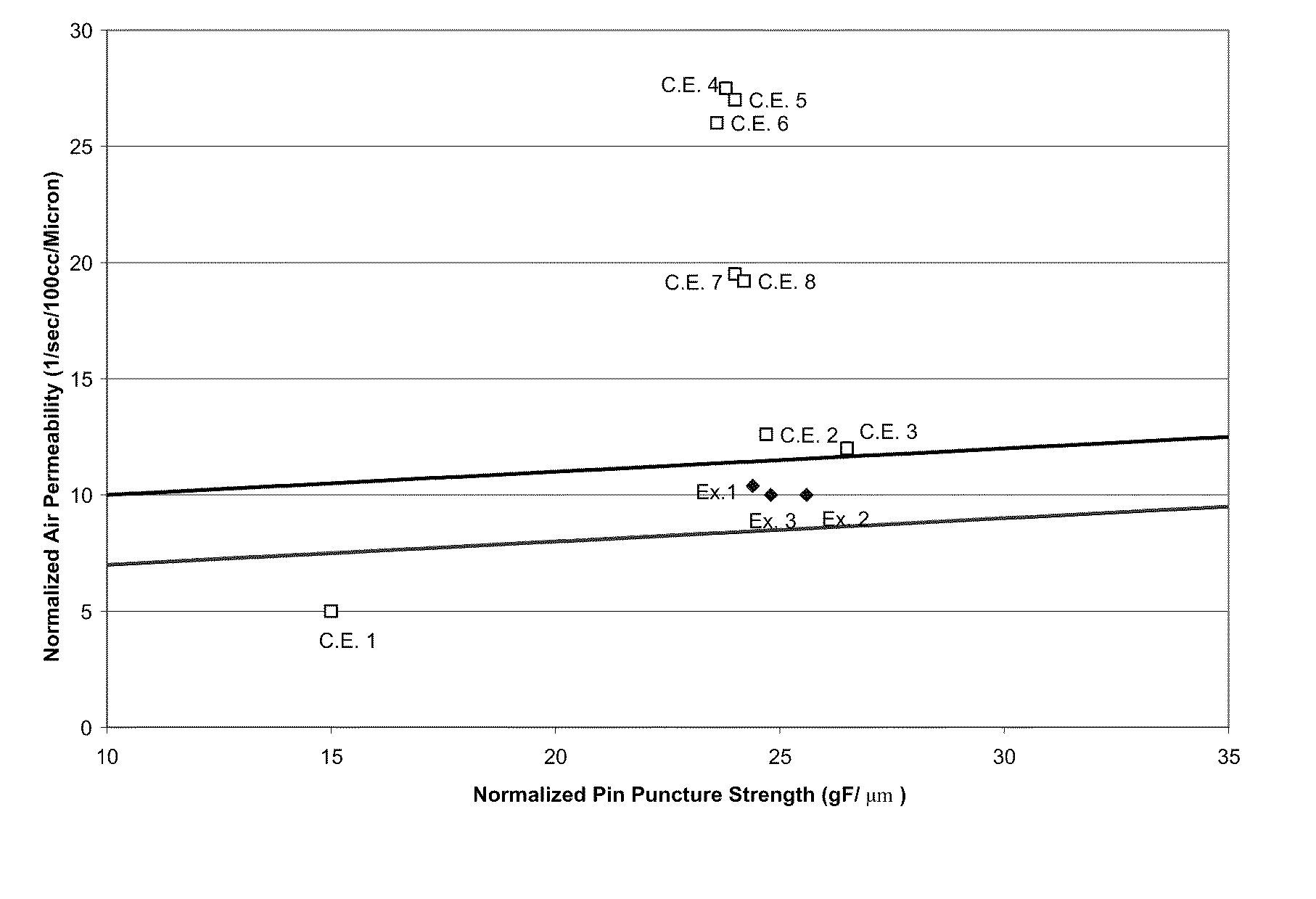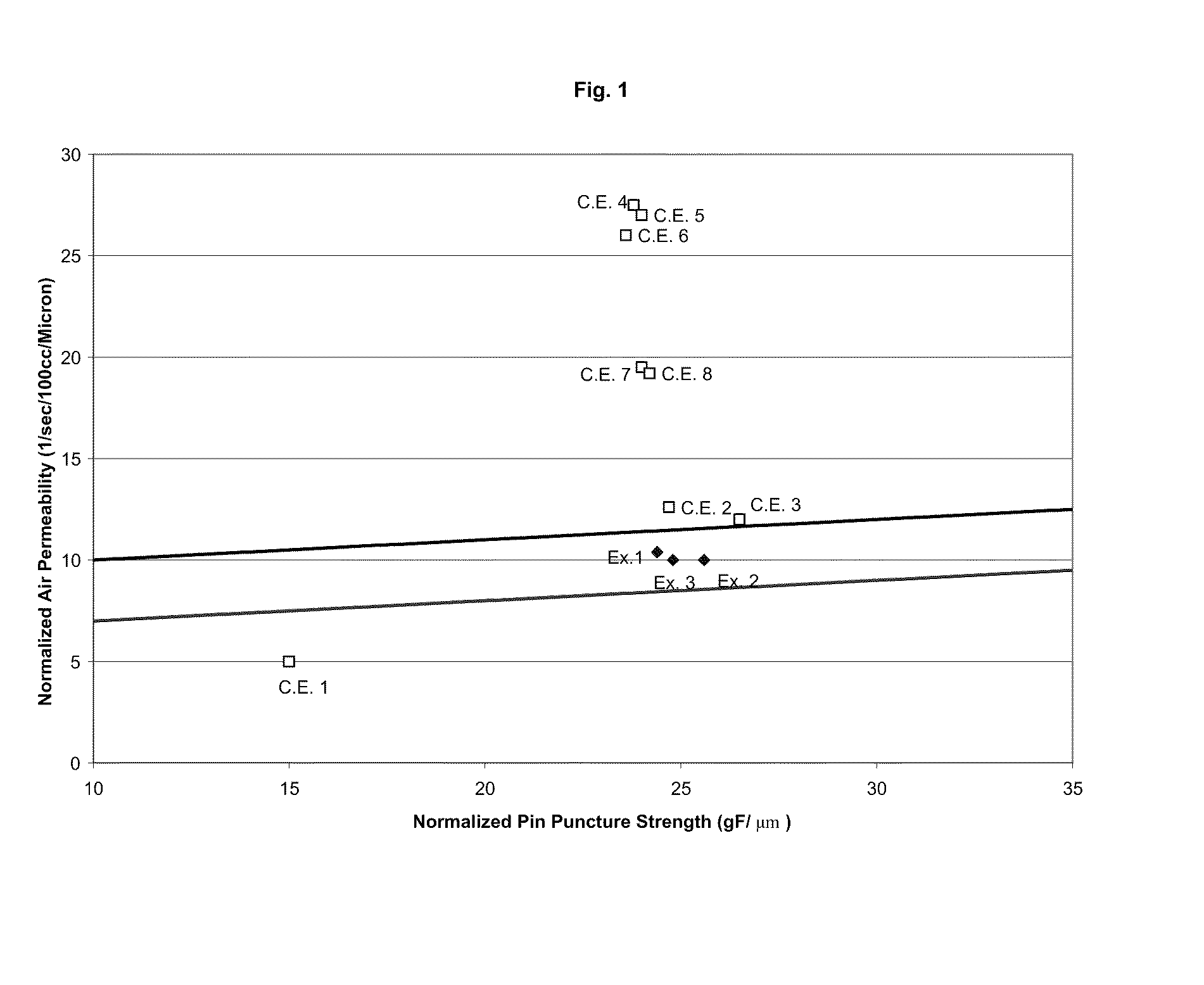Microporous membranes and methods for producing and using such membranes
a technology of microporous membranes and polymeric membranes, applied in the direction of membranes, cell components, cell component details, etc., can solve the problems of unsatisfactory air permeability gurley values, difficult handling of solvents, and high cost of solvents
- Summary
- Abstract
- Description
- Claims
- Application Information
AI Technical Summary
Benefits of technology
Problems solved by technology
Method used
Image
Examples
example 1
[0072]A polyolefin composition is prepared by combining (a) 70.0 wt. % of polyethylene resin having an Mw of 5.6×105, an MWD of 4.1, and having a terminal unsaturation amount of 0.1 per 10,000 carbon atoms (the “second polyethylene”) with (b) 30.0 wt. % of polyethylene resin having an Mw of 2.0×106 and an MWD of 5.1 (the “first polyethylene”). The combined polyethylene resin in the composition has a melting point of 135° C., and a crystal dispersion temperature of 100° C.
[0073]Mw and MWD of the polyethylenes are determined using a High Temperature Size Exclusion Chromatograph, or “SEC”, (GPC PL 220, Polymer Laboratories), equipped with a differential refractive index detector (DRI). Three PLgel Mixed-B columns (available from Polymer Laboratories) are used. The nominal flow rate is 0.5 cm3 / min, and the nominal injection volume is 300 μL. Transfer lines, columns, and the DRI detector are contained in an oven maintained at 145° C. The measurement is made in accordance with the procedu...
example 2
[0077]A polyolefin composition comprising (a) 70.0 wt. % of the second polyethylene resin of Example 1 and 30.0 wt. % of the first polyethylene resin of Example 1 is prepared by dry-blending. The percentages are based on the weight of the polyolefin composition. The polyethylene resin in the polyolefin composition has the same melting point and crystal dispersion temperature as in Example 1.
[0078]30.0 wt. % of the resultant polyolefin composition is charged into a strong-blending double-screw extruder with 70 wt. % of liquid paraffin (50 cst at 40° C.), based on the combined weight of the polyolefin composition and the liquid paraffin. Melt-blending is conducted at 210° C. to prepare a polyethylene solution. This polyethylene solution is extruded from a T-die mounted to the double-screw extruder. The extrudate is cooled while passing through cooling rolls controlled at 40.0° C., to form a cooled extrudate, i.e. gel-like sheet having a thickness of 1.4 mm.
[0079]Using a tenter-stretch...
example 3
[0080]Example 2 is repeated except that the thickness of the cooled extrudate is 1.2 mm and the dry orientation is conducted with the membrane exposed to a temperature of 127.7° C. The properties of the membrane are shown in FIG. 1 and Table 1. The average micro-fibril diameter is 48 nm, and the average distance between micro-fibrils is 480 nm at the surface of the membrane.
PUM
| Property | Measurement | Unit |
|---|---|---|
| diameter | aaaaa | aaaaa |
| diameter | aaaaa | aaaaa |
| thickness | aaaaa | aaaaa |
Abstract
Description
Claims
Application Information
 Login to View More
Login to View More - R&D
- Intellectual Property
- Life Sciences
- Materials
- Tech Scout
- Unparalleled Data Quality
- Higher Quality Content
- 60% Fewer Hallucinations
Browse by: Latest US Patents, China's latest patents, Technical Efficacy Thesaurus, Application Domain, Technology Topic, Popular Technical Reports.
© 2025 PatSnap. All rights reserved.Legal|Privacy policy|Modern Slavery Act Transparency Statement|Sitemap|About US| Contact US: help@patsnap.com


